Themed collection Research presented at the ICMAT 2019 symposium

Research presented at Symposium P of the 10th International Conference of Materials and Advanced Technology (ICMAT 2019)
Goutam Dalapati, Lydia Wong and Frank Osterloh introduce the Journal of Materials Chemistry A themed collection on Research presented at the ICMAT 2019 symposium.

J. Mater. Chem. A, 2020,8, 843-844
https://doi.org/10.1039/C9TA90275A
Rapid advances in antimony triselenide photocathodes for solar hydrogen generation
The advantages of antimony triselenide (Sb2Se3) over other semiconducting materials for solar-to-hydrogen conversion are highlighted. Rapid recent advances in Sb2Se3 photocathode technology are summarized and future research directions are discussed.

J. Mater. Chem. A, 2019,7, 20467-20477
https://doi.org/10.1039/C9TA07990D
Influence of sodium diffusion from substrates on performance of SnS/CdS thin-film solar cells
The influence of Na diffused from substrates on SnS/CdS thin-film solar cells was investigated.
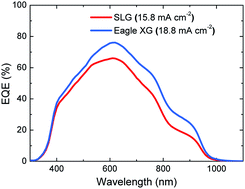
J. Mater. Chem. A, 2019,7, 24186-24190
https://doi.org/10.1039/C9TA08339A
The role of ultra-thin MnOx co-catalysts on the photoelectrochemical properties of BiVO4 photoanodes
MnOx suppresses surface recombination by enhancing band bending on BiVO4, but direct contact with the FTO substrate provides shunting pathways.
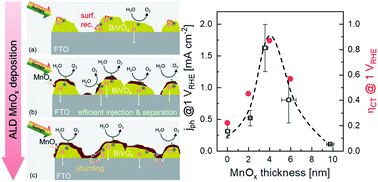
J. Mater. Chem. A, 2020,8, 5508-5516
https://doi.org/10.1039/D0TA00939C
Eco-friendly quantum dots for liquid luminescent solar concentrators
Eco-friendly Cu doped Zn–In–Se QDs for liquid luminescent solar concentrators can provide a platform of more efficient and environmentally friendly solar energy harvest systems.
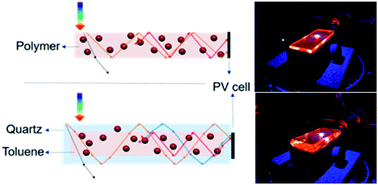
J. Mater. Chem. A, 2020,8, 1787-1798
https://doi.org/10.1039/C9TA09586A
Beyond 10% efficiency Cu2ZnSnS4 solar cells enabled by modifying the heterojunction interface chemistry
ZnCdS buffer layers deposited from high concentration ammonia enable a less defective interface and over 10% efficiency Cu2ZnSnS4 solar cell.
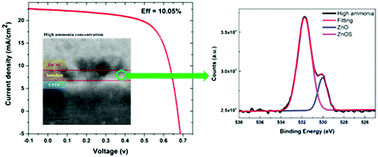
J. Mater. Chem. A, 2019,7, 27289-27296
https://doi.org/10.1039/C9TA09576D
Effect of Cd on cation redistribution and order-disorder transition in Cu2(Zn,Cd)SnS4
The difference in the order-disorder transformation leads to a reduction in atomic disorder in Cu2CdSnS4 as compared to Cu2ZnSnS4.
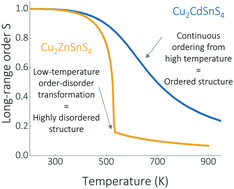
J. Mater. Chem. A, 2019,7, 26927-26933
https://doi.org/10.1039/C9TA09572A
Plasma assisted vapor solid deposition of Co3O4 tapered nanorods for energy applications
Self-standing, 1-dimensional (1D) structures of p-type metal oxide (MOx) have been the focus of considerable attention, due to their unique properties in energy storage and solar light conversion.
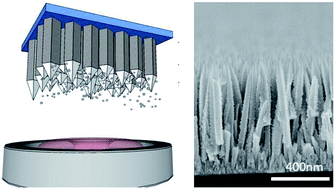
J. Mater. Chem. A, 2019,7, 26302-26310
https://doi.org/10.1039/C9TA08055D
Controlled synthesis of (hk1) preferentially oriented Sb2Se3 rod arrays by co-evaporation for photovoltaic applications
In this paper, we propose that the microstructural control of (hk1) preferentially oriented Sb2Se3 films from flat films to rod arrays can improve their photovoltaic efficiency by maximizing the carrier transport characteristics.
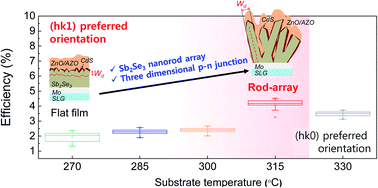
J. Mater. Chem. A, 2019,7, 25900-25907
https://doi.org/10.1039/C9TA08289A
Nano-scale sulfurization of the Cu2ZnSnSe4 crystal surface for photovoltaic applications
A new and effective method for nano-scale sulfurization of the Cu2ZnSnSe4 crystal surface was developed.
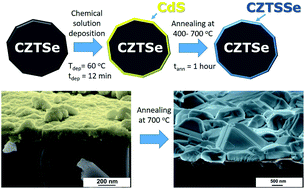
J. Mater. Chem. A, 2019,7, 24884-24890
https://doi.org/10.1039/C9TA08020A
Flexible high-efficiency CZTSSe solar cells on stainless steel substrates
Stainless steel (SS) foil is made of abundant materials and is a durable and flexible substrate, but the efficiency of a solar cell on SS foil deteriorates via the diffusion of impurities from the SS substrate into a Cu2ZnSn(S,Se)4 (CZTSSe) absorber layer.
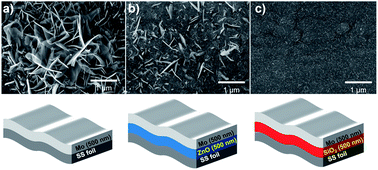
J. Mater. Chem. A, 2019,7, 24891-24899
https://doi.org/10.1039/C9TA08265D
The effect of Ag alloying of Cu2(Zn,Cd)SnS4 on the monograin powder properties and solar cell performance
The reported results confirm that the positive effect of Ag in (Cu1−xAgx)1.85(Zn0.8Cd0.2)1.1SnS4 MGL solar cells appears only at very low Ag concentrations (x ≤ 1%).

J. Mater. Chem. A, 2019,7, 24281-24291
https://doi.org/10.1039/C9TA07768E
Effects of S and Se contents on the physical and photovoltaic properties of Cu2ZnSn(SX, Se1−X)4 thin films: achieving a PCE of 9.47%
CZTSSe thin films with various S/(S + Se) compositions were synthesized by adding SeS2 powder in an optimized selenization process.
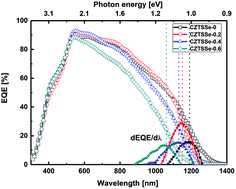
J. Mater. Chem. A, 2019,7, 22986-22995
https://doi.org/10.1039/C9TA08319G
About this collection
This themed collection includes invited research from topics presented at the symposium Advanced Inorganic Materials and Thin Film Technology for Solar Energy Harvesting and Electronic Application, at the 10th International Conference on Materials for Advanced Technologies (ICMAT), 2019. Guest Edited by Professor Lydia Helena Wong, Nanyang Technological University, Singapore, Professor Goutam Kumar Dalapati, SRM University-AP, Amaravati, India, and Professor Frank Osterloh, Journal of Materials Chemistry A Associate Editor, University of California Davis, USA